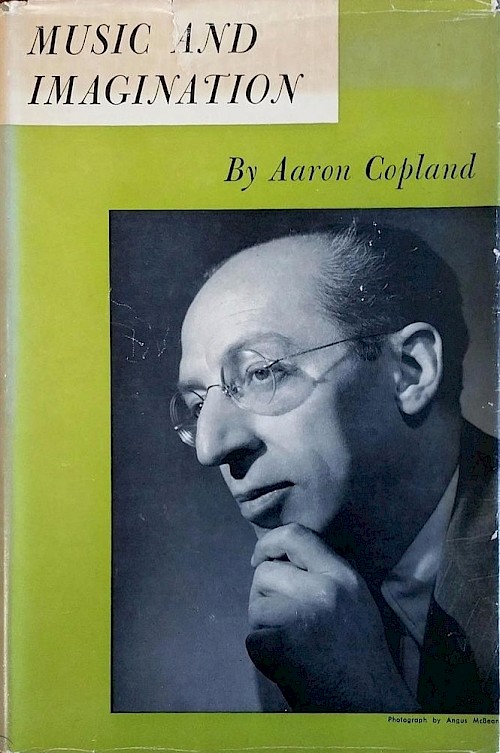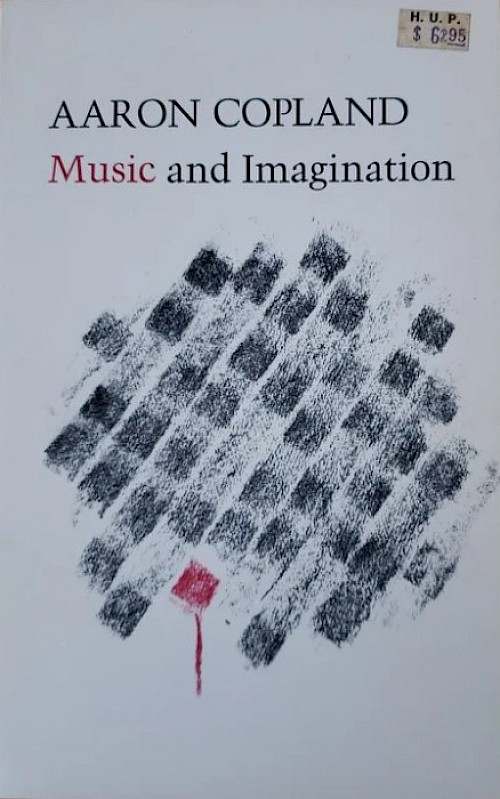Aaron Copland's Music and Imagination first appeared in bookstores 70 years ago this season, perfectly timed for holiday gift-giving. Then as now, the book stands as a testament to Copland's continued good-will toward the broad listening public and his commitment to contemporary music.
Which Audience?
Modern music was the subject of lively public debates in postwar America. Members of the educated middle classes discussed the future of classical music on the pages of the New York Times and magazines like Gramophone, Musical Courier, and Musical America. Some artists and intellectuals felt threatened by what they saw as a growing group of nonprofessionals whose tastes and opinions carried undue weight. One literary critic, Dwight Macdonald, coined the term "middlebrow" to describe consumers of art who fell somewhere between the lowbrow masses and the highbrow experts.
Copland knew well the outlines of this midcentury culture war. By December 1952, he had supporters on both sides. Advocates of so-called high culture admired his achievements as a skilled, European-trained composer of orchestral music. Middlebrow listeners embraced his Hollywood film scores and his tuneful, populist works like Lincoln Portrait, Appalachian Spring, and Fanfare for the Common Man.

Lecture/Book Contents
When Harvard University invited Copland to deliver the prestigious Norton Lectures during the 1951-52 academic year, it signaled his acceptance into the upper echelon of American intellectual life. Previous Norton Professors of Poetry had been Igor Stravinsky in 1939, American playwright Thornton Wilder, and German composer Paul Hindemith. Copland was the first American born musician to receive the honor.
Copland presented three public lectures in the fall semester, and three in the spring. The perceived divide between artists and intellectuals on the one hand, and the broad listening public on the other, was a frequent topic in Copland's talks. In the draft of one chapter, he took the expert's side, wondering "how the mass audience [is] to be served and we, the artists, manage at the same time to save our creative souls.” His longstanding respect for the broad public, however, seems to have tempered his phrasing, for in the book, he settled on a milder discussion of "the importance of mass media to the distribution of music."
He called the first set of lectures “Music and the Imaginative Mind” and the second set “Musical Imagination and the Contemporary Scene.” The first two talks, “The Gifted Listener” and “The Sonorous Image,” considered abstract questions of musical meaning. He drew from the thought of aesthetic philosophers Suzanne Langer, Van Wyck Brooks, I. A. Richards, and Charles Eliot Norton, for whom the lectures were named. In third lecture, “The Creative Mind and the Interpretative Mind,” he examined the respective roles of composer and performer in music making.
Lectures four through six considered music's role in modern society. “Tradition and Innovation in Recent European Music” considered whether complex, advanced music could be suitable for mass audiences, especially in countries whose governments directly supported - or regulated - the arts. “Musical Imagination in the Americas” described the rhythmic, melodic, and harmonic materials that helped distinguish American from European music. Finally, “The Composer in Industrial America,” laid out the challenges facing concert-music composers in countries like the U.S. “Only an imaginative mind could possibly conceive itself a composer of serious music in an industrial community like the United States,” he said Elliott Carter once told him (Music and Imagination, p.96).

Marketing Music and Imagination
Copland's lectures were published with minimal revisions by Harvard University Press late in 1952 as Music and Imagination. In the middlebrow economy, the book and its author became a marketable product. To assess which consumers were likely to purchase the book, the press solicited comments from an outside reader who had attended the lectures.
The outside reader anticipated that two factors would ensure success in the American market: Copland’s name recognition, and national pride in his achievements. Academic and music libraries would purchase the book, he predicted, as well as most public libraries. Many individual purchasers would appreciate Copland's “down-to-earth tone” and “readability.” With a touch of condescension, the reader added, “it will not frighten away the book-of-the-month club intellects.”
Marketers at the press used Copland's photographic likeness to promote book: His profile dwarfed the Harvard coat of arms in an advertisement they placed in the New York Times (October 12, 1952). The timing of the book’s release, shortly before Christmas, landed it in a few gift recommendation columns.
As a sneak preview, the publisher released an excerpt from Chapter 1. Several major news outlets printed it directly or quoted substantial portions. The selection seemed calculated to provoke controversy, for in it, Copland roundly criticized the conservative tastes of the American musical establishment.
“The simple truth is that our concert halls have been turned into musical museums—auditory museums of a most limited kind," Copland wrote (Music and Imagination, p.19). "Our musical era is sick in that respect—our composers invalids who exist on the fringe of musical society, and our listeners impoverished through a relentless repetition of the same works signed by a handful of sanctified names.” He further protested that "Reverence for the classics in our time has been turned into a form of discrimination against all other music.”

Critics and readers alike took the bait. In The New York Times Magazine (September 21, 1952), printed the full excerpt below a lengthy headline that read “An Indictment of the Fourth B: It is Boredom / with repetition of Beethoven, Bach and Brahms and it is stifling our modern music, this composer argues.” Many readers wrote letters to the editor in response. An accountant from Queens wrote, “That contemporary music doesn’t have a larger place in our concert halls may be attributed to the fact that so many present-day composers speak in an idiom—atonalism—which not many find appealing either to the ear or the intellect." An anonymous writer used Longfellow-inspired doggerel to describe a recent concertgoing experience: "I hear, instead, a ‘modern,’ / Which is blared and scraped and hissed..." The Times Magazine printed only one letter that supported Copland’s call for more adventurous, modernist programming.
In the Saturday Review of Books (October 25, 1952), critic Wilder Hobson largely agreed with Copland’s dismay about the "musical museum." The New Republic critic Robert Evett (October 27, 1952) was in partial agreement: “greatness is a vastly over-rated quality in music…the masterpiece notion has been strangling the art by limiting the performing repertory and with it the imagination of the concert audience.” But Evett objected to Copland's assertion that modernist dissonances were the wave of the future. “Though, as [Copland] says, ‘interesting sonorities are scarcely more than the icing on the musical cake,’ it is frequently just this icing that makes many of us unwilling to swallow the cake itself.”
In the New York Times Book Review, Bernard Haggin invoked his "listener's privilege" to directly contradict Copland's favorable opinion of the notoriously concise and dissonant Second Viennese composer Anton Webern; he called Copland's criticism of middlebrow taste a "misstatement." The marketing department at Harvard University Press were no doubt delighted by these public arguments, for they brought considerable attention to the book and its author.
Reception of Book and Author
When reviews of the complete book appeared, the outside reader's predictions of a warm reception were fulfilled. At least twenty reviews appeared in North American daily newspapers in cities on both coasts and throughout the Midwest. Many other reviews appeared in weekly, monthly, and quarterly periodicals. Few of them dwelt on Copland's more controversial statements. Instead, they expressed national pride in both his international reputation, and in his respect for the broad American public.

In the Musical Quarterly (January 1953), Richard Goldman expressed national pride. He wrote, “The selection of Copland as the first American musician to occupy the Norton Chair of Poetry was as gratifying as it was inevitable, and it is to be hoped that the prestige of the Norton Chair will broaden the prospective audience." In Goldman's eyes, middlebrow appeal was an asset, not a threat. He noted Copland’s “consistent tone…of benevolent optimism” which was “as unforced as it is unusual.” Copland held "the moral distinction one wishes to see in the teacher,” and his book was "a critical contribution full of hope and affirmation.”
In colorful prose, Wilder Hobson's review thumped the Americanist drum. "One inevitably fascinating thing about Aaron Copland is the fact of his Americanism and what his life and his musical intelligence have to reveal about music in this country," he wrote. Copland was a returning hometown hero, "born and raised in deepest Brooklyn, an alumnus of that large and remarkable institution called the Brooklyn Boys’ High School…He went from Brooklyn to Paris. Under such foreign teachers as Nadia Boulanger he became an utterly sophisticated composer. And then he came home and began to make splendid use of the usable American past."
Hobson's term "usable past" was coined by Harvard-educated cultural critic Van Wyck Brooks, whose writings also informed Music and Imagination. From a 21st century vantage point, one might say that Hobson, Copland, Brooks, and other writers in the midcentury United States were using a common vocabulary to describe—and create—a myth of American cultural equality with Europe. Music and Imagination situated Copland firmly at the center of that mythology.
Conclusion
Music and Imagination—its content, its marketing, and its critical reception—shows that by 1952 Copland had become a central figure in the midcentury tug-of-war between middlebrow audiences and intellectuals, as it played out in various publications of the day. Copland had achieved a public image as an American expert of international standing who was also passionately engaged with the general American public.
Music and Imagination's visibility and critical success show that Copland had attained a reputation as congenial, yet learned; American, yet of international caliber; accessible, yet also highbrow. By engaging with the economically powerful American middlebrow on the issues that captivated them most, in the 1950s Copland rose above the fray of modernism-vs-classics and middlebrow-vs-elites to become a valued public intellectual.
Further Reading
- Aaron Copland Collection, Library of Congress, Box 204. Drafts and publicity concerning Music and Imagination.
- DeLapp, Jennifer. “Speaking to Whom? Modernism, Middlebrow, and Copland’s Short Symphony,” in Copland Connotations: Studies and Interviews, ed. Peter Dickinson (Rochester, N.Y.: Boydell & Brewer, 2002), 96-97.
- Copland, Aaron. Music and Imagination. Cambridge, Mass: Harvard University Press, 1952.
- Goldman, Richard F. “Reviews of Books: Music and Imagination by Aaron Copland,” Musical Quarterly 39:1 (January 1953), 107-109.
- Hobson, Wilder. Saturday Review of Books, October 25, 1952, 33.
- Letters to the Editor, New York Times. September 28, 1952, sec. 6, p. 2; October 5, 1952, sec. 6, p. 6.



